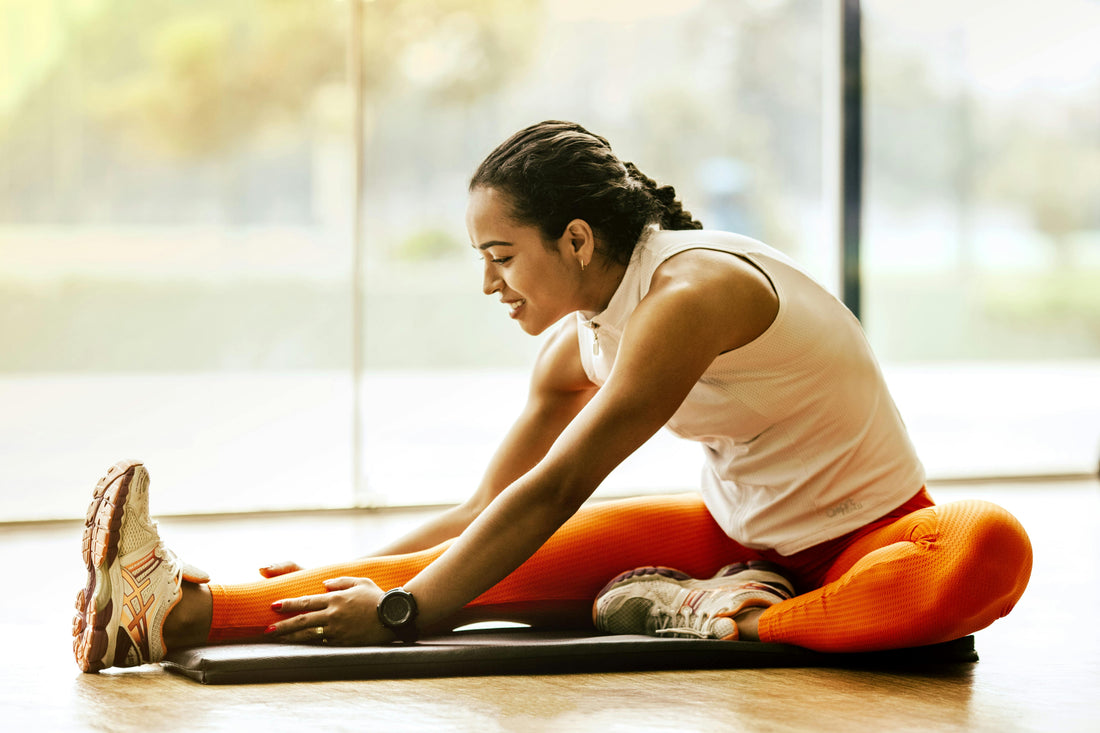Hey there, sports families!
We talk a lot about hitting hard, running fast, and jumping high in sports, right? We focus on building strong muscles and having great stamina. But what if I told you there's a hidden piece of the puzzle, something super important that often gets forgotten? It's something that can take an athlete from good to great, help them stay in the game longer, and even bounce back faster after playing. That secret weapon? Flexibility!
Think of your body like a really cool machine. Your muscles are like the engine, giving you power. But your flexibility is like the oil that keeps all the parts moving smoothly and freely. Without enough "oil," the machine can feel stiff, maybe not work as well as it could, and even break down sometimes.
This is especially true for young athletes whose bodies are still growing and changing quickly. They're pushing themselves, trying new moves, and putting their bodies in all sorts of positions. Let’s be realistic here, injuries are part of sports and unfortunately bound to happen at some point. However, being flexible helps their bodies handle all that action.
Why is "Being Bendy" Such a Big Deal in Sports?
It might not seem as exciting as scoring a goal or hitting a home run, but improving flexibility has a HUGE impact on how well an athlete performs.
- Better Movement: When muscles are flexible, joints can move through their full range of motion. This means an athlete can swing a bat further, kick a ball with more power, jump higher, and change direction faster. Think about a swimmer needing to reach and pull through the water – flexibility in the shoulders and back is key!
- Increased Power: It sounds strange, but a more flexible muscle can actually create more power. When a muscle can lengthen fully before it shortens to create movement, it's like stretching a rubber band further back before you let it go – you get more snap and force!
-
Improved Technique: Good flexibility allows athletes to get into the correct positions for their sport. This helps with proper technique, which not only improves performance but also makes movements more efficient.
Flexibility: Your Injury Prevention Superhero!
Nobody wants to be sitting on the sidelines because of an injury. And this is where flexibility really shines as a superhero!
- Less Muscle Strain: Tight muscles are like a stretched rubber band that's about to snap. When you ask a tight muscle to suddenly stretch or move powerfully, it's much more likely to get pulled or strained. Flexible muscles can handle the demands of sports movements much better.
- Balancing Act: Sometimes, one muscle group can become much stronger or tighter than the muscles around it. This can pull your body out of balance and put extra stress on joints and ligaments, leading to injury. Stretching helps keep muscles more balanced.
-
Better Body Awareness: As athletes stretch and become more flexible, they often become more aware of their bodies and how they feel. This can help them notice if something feels "off" before it turns into a bigger problem.
Helping the Body Bounce Back: Flexibility and Recovery
After a tough practice or game, muscles can feel tight and sore. Stretching plays an important role in helping the body recover.
- Reduced Soreness: While the science is still being explored, many athletes find that gentle stretching after exercise helps to reduce that stiff, sore feeling the next day.
- Increased Blood Flow: Stretching can help improve blood flow to the muscles. More blood means more oxygen and nutrients getting to the muscles, which helps them repair and recover faster.
-
Feeling Good: Simply put, stretching can help athletes feel more relaxed and less tight after working hard. This can improve their overall comfort and well-being.
Stretching Smarts: Dynamic vs. Static vs. PNF
Not all stretching is the same! There are different ways to stretch, and knowing when to use each one is important for athletes.
-
Dynamic Stretching (Warm-up Hero): Think of dynamic stretching as stretching through movement. These are controlled movements that take your joints and muscles through a range of motion. Examples include arm circles, leg swings, and torso twists.
- When to use it: BEFORE sports or exercise. Dynamic stretching helps warm up the muscles, gets blood flowing, and prepares the body for the movements it's about to do. It's like gently getting the machine ready to work.
-
Static Stretching (Cool-down Companion): This is probably what you picture when you think of stretching. It involves holding a stretch position for a period of time, usually 20-30 seconds, feeling a gentle pull in the muscle. Examples include holding a hamstring stretch or a triceps stretch.
- When to use it: AFTER sports or exercise. When muscles are warm, static stretching can help improve flexibility over time. It's like helping the machine wind down and promoting longer-term flexibility gains. Avoid deep static stretching before intense activity, as it might temporarily reduce power.
-
PNF Stretching (Partner Power-Up): PNF stands for Proprioceptive Neuromuscular Facilitation (a fancy term!). This type of stretching often involves a partner and uses a mix of stretching and muscle contractions to help a muscle lengthen more effectively. There are different ways to do it, but a common method involves stretching a muscle, then briefly tightening that muscle against resistance, and then stretching it further.
- When to use it: PNF is an advanced technique often used to significantly improve range of motion in specific areas. It's usually done with a coach or trainer who knows the right way to do it safely. It's often used on muscles that are particularly tight.
-
SMR (Self Myofascial Release): SMR is often done with tools like foam rollers, is beneficial before physical activity because it can help to temporarily improve flexibility and range of motion without negatively impacting muscle performance. It's thought to do this by reducing muscle tightness and increasing blood flow to the targeted areas, potentially preparing your body for movement.
- To perform SMR effectively, first identify the muscle you intend to target. Then, apply a comfortable but firm pressure using your body weight and the tool, focusing on any tender areas or trigger points. Roll slowly along the muscle's length, and when you find a sensitive spot, hold pressure there for 30 to 90 seconds until you feel a release.
-
When to use it: SMR is a very versatile stretching option as you can do it, at any time for the most part.
- Before Exercise: Performing SMR as part of your warm-up can help improve blood flow to the muscles and temporarily increase flexibility and range of motion. Focus on the muscle groups you'll be using during your workout.
- After Exercise: SMR post-workout can aid in reducing muscle soreness and improving recovery by helping to flush out metabolic waste and reduce muscle tension.
- On Rest Days: Even on days you aren't actively exercising, SMR can be beneficial for maintaining muscle health, preventing stiffness, and promoting relaxation.
-
Before Bed: A gentle SMR session before sleep can help to relax your muscles and potentially improve sleep quality. Anytime you feel muscle tightness or discomfort: You can use SMR as needed to address specific areas of tension and improve comfort.
Putting it into Practice: A Simple Stretching Program
Here's a sample stretching program that young athletes can use. Remember to always warm up the body with some light activity (like jogging in place or jumping jacks) before stretching, especially before static stretching.
Before Sports (Dynamic Stretching - 5-10 minutes):
- Arm Circles (forward and backward) - 10 circles each way
- Leg Swings (forward and backward, side to side - holding onto something for balance) - 10 swings each way per leg
- Torso Twists (standing with hands on hips, gently twisting side to side) - 10 twists each way
- Knee Hugs (bringing one knee towards the chest) - 10 per leg
-
Walking Lunges (taking a step forward and bending both knees) - 10 per leg
- Targeted SMR
After Sports (Static Stretching - Hold each for 20-30 seconds, repeat 2-3 times):
- Hamstring Stretch: Sit with one leg extended, reach towards your toes. Or stand and gently lean forward with one leg slightly in front.
- Quadriceps Stretch: Stand and grab your ankle, gently pulling your heel towards your bottom. Use a wall for balance if needed.
- Calf Stretch: Stand facing a wall, place one foot back with the heel on the ground, and lean forward.
- Hip Flexor Stretch: Kneel on one knee, with the other foot in front. Gently push your hips forward.
- Chest Stretch: Stand in a doorway, place your forearm on the doorframe, and gently lean forward.
- Triceps Stretch: Bring one arm overhead, bend the elbow, and gently pull the elbow with the opposite hand.
- Butterfly Stretch: Sit with the soles of your feet together and gently let your knees fall outwards.
-
Targeted SMR
How to Stretch Properly (Listen to Your Body!)
- Warm-up First: Never static stretch cold muscles. Get the blood flowing with some light movement.
- Gentle Pull, Not Pain: You should feel a stretch, but it should not hurt. If you feel sharp pain, ease up.
- Hold Steady: For static stretches, hold the position without bouncing. Bouncing can actually cause small tears in the muscle.
- Breathe: Remember to breathe deeply and relax while you're stretching. Don't hold your breath.
- Be Consistent: A little bit of stretching regularly is much better than long, infrequent sessions. Aim for a few times a week.
- Listen to Your Body: Every athlete is different. Pay attention to how your body feels and don't force a stretch.
Flexibility might be the hidden aspect of sports, but its impact is clear to see in better performance, fewer injuries, and faster recovery. By making stretching a regular part of their routine, young athletes can unlock their full potential and enjoy playing the sports they love for years to come. It's an investment in their athletic future and their overall well-being. So, let’s bend it like…you know!
Ready to take your training to the next level and stay ahead of the game? Don't let your fitness journey plateau! Head over to our website to dive deeper into our blog for more expert tips and explore our range of training E-Books. Make sure to follow us on Instagram and Facebook.
Want to be the first to know about the exciting launch of our revolutionary HEROS Training System and upcoming physical products from ACTOS? Sign up for our newsletter today to get all the updates delivered straight to your inbox.
We value your input! If you have any questions, specific training requests, or recommendations for future blog topics, please don't hesitate to reach out. We're here to support your fitness goals every step of the way. Remember that more is not always better; better is always better!
Until next time!
Gaspar
ACTOS Performance Innovation
*Dr. Gaspar A. Rosario is a seasoned healthcare expert with a Doctorate in Health Sciences and over a decade of clinical experience. His certifications in Weight Management, Performance Enhancement, and Exercise Therapy from the ISSA, coupled with his diverse medical background, position him as a trusted authority in the field.

